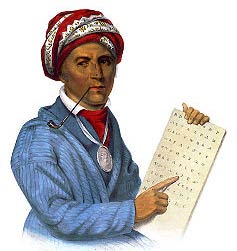Cherokee Indian (1776 – 1843)

This great Cherokee Indian gave his people the enduring gift of a writing system so that the greatness of the Cherokee Nation would live forever. Never before, had one man, not literate in any language, perfected a system for reading and writing a language.
Sequoyah was a silversmith by trade who was also known as George Gist.
In recognition of his contributions, the Cherokee Nation awarded Sequoyah a silver medal created in his honor and a lifetime literary pension. He continued to serve Cherokee people as a statesman and diplomat until his death.
Background
The exact place and date of Sequoyah Gist’s birth is unknown, although it is believed that he spent his early years with his mother in the village of Tuskegee, Tennessee.
The names Sequoyah or Sequoia are both spellings given by missionaries, said to be as corruptions of the Cherokee name Sogwali or Sikwâ’y?, derived from the Cherokee word siqua meaning ‘hog’. This is either a reference to a childhood deformity or a later injury that left him disabled.
His mother, Wut-teh, was a daughter of a Cherokee Chief. Hs father was Nathaniel Gist, a Virginia fur trader.
Sequoyah married a Cherokee and had a family. At some point before 1809, he moved to the Willstown of Alabama where he established his trade as a silversmith.
Sequoyah and other Cherokees enlisted on the side of the United States under General Andrew Jackson to fight the British troops and the Creek Indians in the war of 1812.
Although Sequoyah was exposed to the concept of writing early in his life, he never learned the English alphabet. Unlike the white soldiers, he and the other Cherokees were not able to write letters home, read military orders, or record events as they occurred. After the war, he began in earnest to create a writing system for the Cherokees.
As a silversmith, he dealt regularly with whites who had settled in the area. Often, Native Americans were impressed by their writing, referring to their correspondence as “talking leaves”. Around 1809, Sequoyah began work to create a system of writing for the Cherokee language.
When he returned home after the war, he began to make the symbols that could make words and finally reduced the thousands of Cherokee thoughts to 85 symbols representing sounds. He made a game of this new writing systems and taught his little girl Ayoka how to make the symbols. At first, he attempted to create a character for each word, but he then decided to divide each word into syllables and create one character for each syllable. Utilizing the Roman alphabet and quite possibly the Cyrillic alphabet, he created his 85 characters to represent the various syllables. This work took Sequoyah 12 years to complete (see image of the Cherokee Syllabary).
In 1821, in order to prove the value of his creation to his fellow Cherokee, Sequoyah taught his daughter Ah-yo-ka how to read and write in Cherokee. After amazing locals with his new writing, Sequoyah attempted to display his feat to tribal medicine men only to be rebuffed by them for being possessed by evil spirits. Sequoyah finally proved his feat to a gathering of Chickamaugan warriors and news of the syllabary quickly spread. Cherokee were filling schools in order to learn the new written language. By 1823 the syllabary was in full use by the Cherokee Nation. The writing system was made official in 1825, by which time, much of the Bible and numerous hymns had been translated into Cherokee.
Sequoyah walked to the new Cherokee territory in Arkansas in 1825. There he set up a blacksmith shop and a salt works. He continued to teach the syllabary to anyone who came to him.
By 1828 they were publishing the “Cherokee Phoenix,” the first national bi-lingual newspaper, along with religious pamphlets, educational materials and legal documents.

In the same year, Sequoyah journeyed to Washington, D.C. as part of a delegation to negotiate a treaty for land in Oklahoma. He made contact with representatives of other Native American tribes from around the nation. With these meetings he decided to create a syllabary for universal use among all Native American tribes. With this in mind, Sequoyah began to journey to areas of present day Arizona and New Mexico seeking tribes there. It was on a trip seeking Cherokees who had moved to Mexico that he died between 1843 and 1845. His exact burial location is unknown.
In recognition of his contributions, the Cherokee Nation awarded Sequoyah a silver medal.





